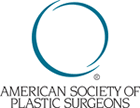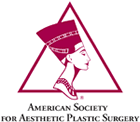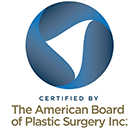
 |
    |
FaceliftRhytidectomy, also known as a facelift, is a surgical procedure to restore a more youthful appearance to the face. As we age, the cumulative effects of gravity, sun exposure, and the stresses of everyday life begin to show in our faces. Deep wrinkles, or rhytids, may form on the forehead, between the eyes, in the crow's feet area, and around the mouth. The skin loses its elasticity, causing the jawline and cheeks to sag. Fat deposits may develop underneath the chin and in the jowl area. A facelift, which usually includes treatment of the neck as well, can improve these visible signs of aging. Rather than give you a different appearance that is, unfortunately, rather common with many facelifting techniques, Dr. Revis strives to restore a more youthful appearance to your face. You won't look different, you will look younger and more refreshed. Dr. Revis accomplishes this using the most advanced and the latest state of the art techniques. The removal of excess skin, tightening of the underlying facial and neck muscles, and redraping of the facial skin are performed with minimal incision techniques that result in less scarring and bruising and a faster return to your normal activities. Facelifting is commonly performed with other procedures to achieve the appearance you desire. Some of the other procedures commonly performed at the same time include brow lifting (raising the eyebrows), blepharoplasty (eyelid surgery), collagen or fat injections (to fill in deep wrinkles), and laser resurfacing or chemical peel (to reduce fine to medium wrinkles and remove age spots). Dr. Revis encourages you to read about these procedures as well. If you think you might be a good candidate for a facelift, this page will give you a basic understanding of the procedure and the results you can expect. The cornerstone of Dr. Revis' approach is to individualize treatment to your specific circumstances and goals and to ensure that you have an adequate understanding of the issues involved so that you are able to make a fully informed decision. This will help you achieve the appearance you desire with the least invasive procedure available, thus creating a mutually rewarding experience. Dr. Revis invites you to visit his office for a complimentary consultation to discuss the procedure in greater detail. You are also invited to email Dr. Revis with your questions, or we can mail you more detailed information regarding the procedure. As you consider plastic surgery, one of the most important decisions you will make is choosing your surgeon. Our pledge to you is to provide the latest, state of the art cosmetic plastic surgery in a safe and professional environment. Dr. Revis is a recognized specialist in the field of cosmetic plastic surgery and is board certified by the American Board of Plastic Surgery, the only plastic surgery board recognized by the American Board of Medical Specialties. He is also an active member of the American Society of Plastic Surgeons and has also been named among "America's Top Surgeons" by the Consumers' Research Council of America. Our goal is to provide you with the ultimate patient experience. Our well-trained staff will help you understand your procedure, our financial policies, the scheduling of your surgery, and your post-operative care. We are available to assist you during our regular office hours, Monday through Friday. Dr. Revis is also available 24 hours a day to post-surgical patients; he will give you his cell phone number after surgery so that you will always be able to reach him with any questions or concerns you might have during your recovery. The ConsultationDuring your initial consultation, Dr. Revis will inquire about your medical history, prior procedures, medications, allergies, and your motivations for seeking plastic surgery. It is very important that you be thorough when providing your medical history, as this information helps to prevent complications during your care. When asked about medications, be sure to include any vitamin or herbal preparations, as these can affect your blood pressure and clotting ability. Honesty regarding your use of tobacco and alcohol is also very important, as these may have a profound impact on your recovery period and your ability to heal following your procedure. After reviewing your medical history, Dr. Revis will discuss your concerns, priorities and motivations for pursuing plastic surgery, as well as your fears. After examining you, Dr. Revis will be able to offer advice and options to help you achieve the appearance you desire. He will explain the advantages and disadvantages of the different options you have before you. You should also bring pictures of yourself at a younger age so that Dr. Revis can evaluate the changes that have occurred over time. At the completion of your consultation, our Patient Coordinator will give you a written estimate of the cost of your procedure. At this time, you will also have the option to schedule your procedure if you so choose. The decision to undergo surgery is a very important one, and the final decision should be given very careful consideration. Dr. Revis realizes the importance of this decision, and at no time will you be pressured to make a decision. You are also encouraged to bring your spouse, significant other, family member, or a friend to your consultation. Types of FaceliftsEndoscopic Midface LiftThis technique has only recently been developed, and Dr. Revis is one of few plastic surgeons trained specifically in this technique. This involves minimal incisions hidden in the hairline above the ear and inside the mouth, so that your scars are virtually invisible. Through these minimal incisions, Dr. Revis uses an endoscope, a small camera the size of a pencil, to elevate and redrape the tissues of the cheek. This procedure can restore high cheek bones and give more definition to the face that is frequently lost with aging. SMAS FaceliftThis technique involves incisions around the ear and into the hairline behind the ear. Through these incisions, Dr. Revis elevates the skin of the face, allowing him to tighten the underlying muscles that sag with aging. The SMAS, or superficial muscular aponeurotic system, is the anatomical term for the muscles, suspensory ligaments, and support structures of the face. This technique can also restore high cheek bones and improve definition of the face. It also has the added benefit of reducing fat collections in the jowl area. After Dr. Revis tightens the muscles of the face, he redrapes and removes excess skin. Neck Lift with PlatysmaplastyThis procedure is commonly performed in addition to one of the above facelifting techniques. Platysmaplasty is another term for tightening the muscles of the neck. Through a minimal incision beneath the chin, Dr. Revis may remove fat collections in the neck or jowl area with liposuction. After the fat has been removed, Dr. Revis tightens the muscles of the neck. This reduces the tendency of the neck skin to hang, and removes any double chin that may be present. Additionally, this technique removes any vertical bands that have formed in the neck. The neck is one of the most critical aspects of facelifting, as the neck often reveals one's true age. With the above techniques, Dr. Revis is able to rejuvenate the entire face, from the base of your neck to your forehead. Where Your Procedure Will Be PerformedDr. Revis has been granted staff privileges at our local hospitals and outpatient surgery centers. In the interest of the safety of his patients, he only performs surgery in fully accredited facilities with the proper services and staff. Dr. Revis usually performs facelifts at Broward General Medical Center or Imperial Point Medical Center (fully accredited hospitals) or the Imperial Point Surgery Center (a fully accredited ambulatory surgery center). The staff of these facilities are very experienced in the care of plastic surgery patients in general and specifically in the care of Dr. Revis' patients. Types of AnesthesiaAnesthesia is an essential part of any surgical procedure and must be performed safely. General anesthesia is the deepest form of anesthesia. You are asleep, feel no pain, and will not remember the procedure. This form of anesthesia is usually not required for facelifts unless the patient specifically requests general anesthesia. Intravenous sedation, called twilight sleep, is a combination of local anesthetic administered at the surgical site by Dr. Revis and intravenous sedation administered by the anesthesiologist. You breathe for yourself, but you are in a deep sleep throughout the procedure. You should feel no pain, and you will not remember the procedure. An intermediate form of anesthesia, the laryngeal mask airway (LMA), is a relatively new technique. This technique is similar to twilight sleep in that you are breathing on your own, but the method of sedation differs. With an LMA, you actually breathe anesthetic gases administered by the anesthesiologist, rather than receive intravenous sedation via your intravenous line. These anesthetic gases cause you to sleep during the procedure. At the completion of the procedure, the gases are turned off and you wake up from your sleep. You will feel no pain, and you will not remember the procedure. This is the most common type of anesthesia used by Dr. Revis because he feels that the effects of this type of anesthesia leave your body the fastest, allowing you to feel better faster with very little likelihood of post-operative nausea. The prevention of post-operative nausea and vomiting is also a focus of Dr. Revis' approach to facelift surgery. To improve your overall experience and ensure you feel better faster following your facelift, he has developed a technique that has resulted in a very low incidence of post-operative nausea and vomiting. You will be given an intravenous dose of Zofran at the beginning of your operation. Zofran is a new drug which is currently the best medication available to prevent nausea and vomiting. Dr. Revis feels it is a very important component of his overall approach to make sure that your experience is as pleasant as possible. Dr. Revis will discuss all of these options with you more thoroughly at the time of your consultation, and please ask him about anything you do not understand. Details of the ProcedureFacelift surgery usually takes three to four and a half hours to perform, depending on whether or not you are having additional procedures performed at the same time. After you are properly anesthetized, Dr. Revis will make the minimal incisions necessary for insertion of the endoscopic camera. Through these limited incisions, Dr. Revis works with small instruments to elevate the skin of the face and neck. He may perform liposuction in the jowl area or beneath the chin if you have these troublesome collections of fat. After the skin is elevated, Dr. Revis repositions the cheek tissues and tightens the underlying muscles, or SMAS. With very precise suture techniques, these tissues are resuspended and the muscles are tightened. After the completion of this step, Dr. Revis trims any extra skin that is present. After tightening the muscles of the neck, Dr. revis will carefully close the incisions to minimize your scars. A drain may be placed beneath the incision. This slender, rubber tube assists in draining any fluid that may accumulate beneath the incision and delay your healing. Dr. Revis may also chose to use a new product called Tissue Glue. This product helps your body heal and minimizes the fluid that may empty into your drain, allowing the drains to be removed earlier or may make a drain unnecessary. Afterwards, a sterile dressing is applied to the incisions. Products to Help You HealSilagen Made with 100% pure medical grade silicone, Silagen 100% Pure Silicone Gel for Scars is clear, fast drying gel that will help flatten, soften and smooth scars. It also helps reduce redness, discoloration, itching, and pain. SinEcch Arnica Montana is a natural product from Sweden which has been shown in clinical studies to reduce post-operative bruising and swelling. Begun the evening prior to surgery, this product is continued for four days post-operatively. These products are available for purchase in our office. Please ask us about these products and others if you have any further questions about whether or not these would be beneficial for you during your healing period. After Your ProcedureFacelifting may be performed as an outpatient procedure, or you may choose to spend the night in the hospital. Most patients choose to stay overnight, particularly if they live alone or are from out of town. We also have a private duty nurse available to care for you in the comfort and privacy of your own home if you so choose. After recovering in the recovery room for approximately one hour, you will be able to go home in the company of a friend or family member or will be transported to your room. Dr. Revis will remove your dressing the day after surgery, either in his office or in the hospital. Another light dressing may be placed at that time if he feels it is necessary. You should wear a hat, sunglasses, and scarf to protect yourself from the sun and to provide a degree of modesty. The antibiotics that were prescribed during your preoperative visit (usually Augmentin) should be taken twice daily beginning on the evening prior to surgery. Continue this medication for five days post-operatively or until it is gone. The pain medication prescribed by Dr. Revis during your preoperative visit (usually Lortab or Vicodin) should be taken fairly regularly, every four hours or so, during the first 24 hours (when you are not asleep, of course). Most patients find that they are able to transition to Tylenol after three or four days. It is not safe to drive a car within 24 hours of taking pain medication, as your reflexes and alertness may be altered. You should plan to take it easy following your surgery. No strenuous activities, heavy lifting (over 20 pounds), aerobic exercises, swimming, contact sports, tennis, or golf should be planned for the first several weeks. As Dr. Revis monitors your recovery, he will advise you when it is safe to resume specific activities. The Results You Can ExpectYou will notice an improvement in the appearance of your face after approximately one week. It will take a total of three or more weeks for the swelling to resolve completely. You may experience numbness of the facial skin for several weeks, so it is important to test the temperature of your bath or shower. You should be able to resume your normal daily activities the day after surgery, and you should be able to resume all of your physical activities within three weeks of surgery. Facelift Before & After Photos Please call (954) 630-2009 or email Dr. Revis for further information or to schedule a complimentary consultation. Email: DrDonRevis@hotmail.com
|
|
|
Copyright 2022 South Florida Plastic Surgery Associates |